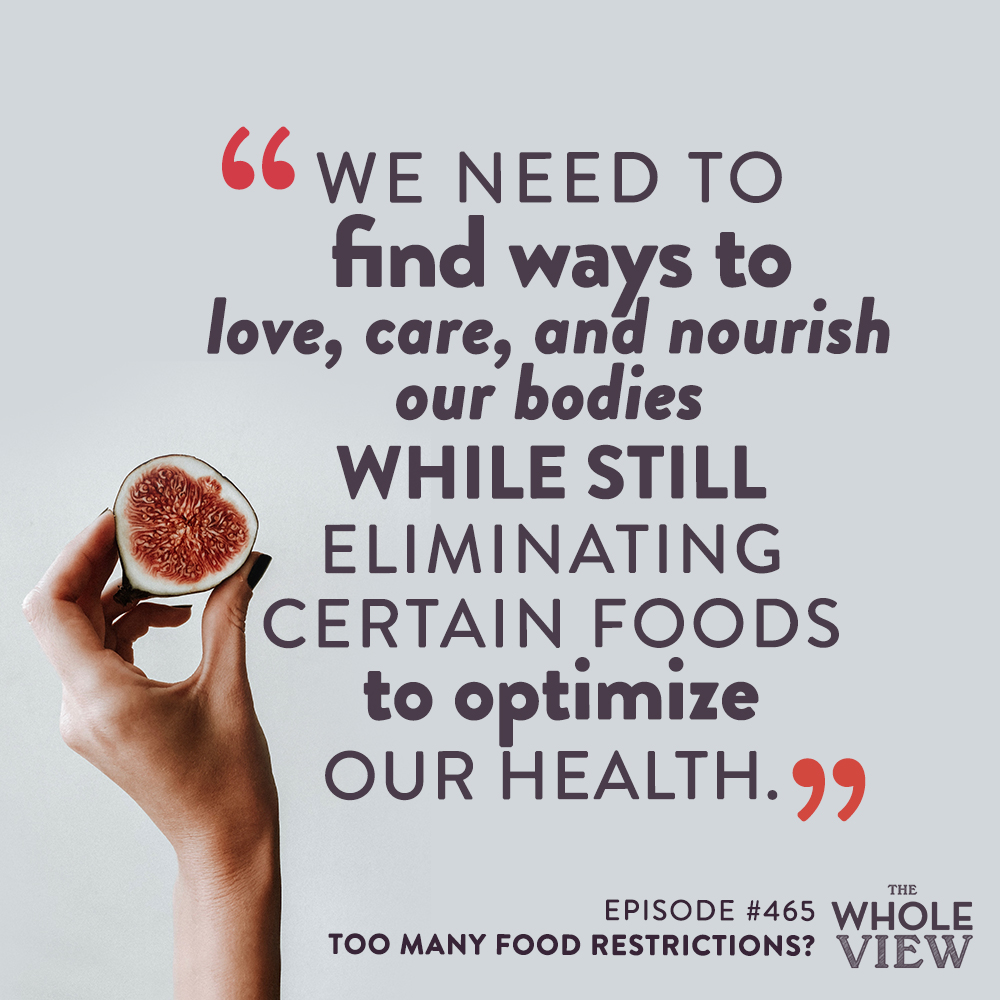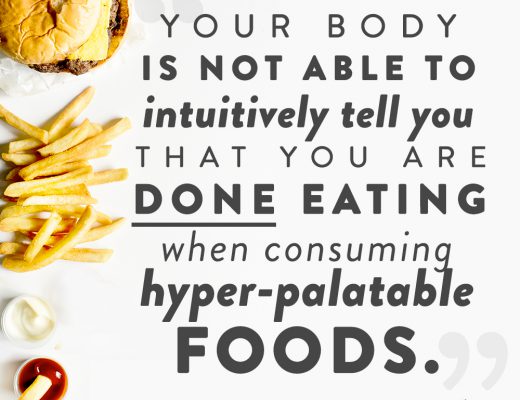
Welcome to episode 465 of The Whole View! This week, Sarah and Stacy dive into the science behind too many food restrictions and the importance of maintaining food variety and nutrient sufficiency. They share several strategies they’ve discovered on their own and offer recommendations to help you get the most out of your health journey.
If you enjoy the show, please review it on iTunes!
The Whole View, Episode 465: Too Many Food Restrictions?
Welcome back to episode 465! (0:28)
Stacy opens the show with a cryptic message to listeners not to sleep on next week’s show because some big news is coming for the Whole View.
Thank you for tuning in each week, leaving reviews, asking questions, and engaging with Stacy and Sarah all these years. Without you, this show would not happen!
This is not a sponsored episode. However, Sandra at ShopAIP created a coupon code just for Whole View listeners. Just use the code “thewholeview” at checkout to receive 15% off your purchase!
Sarah and Stacy’s personal health journeys have led them to a place now where they have a lot of flexibility and a solid understanding of what a sub-optimal choice may have on their bodies.
But, it’s very easy to forget just how overwhelming the process can be when you’re just starting.
This episode was inspired by a listener question:
I’m very grateful to have found your book “The Paleo Approach” at my local library. I have since purchased copies of it and the cookbook for myself and family members because of the vital information in it.
My question is: Having lupus and hypothyroidism causes me to steer clear of various foods and herbs, (nightshades and echinacea) and being gluten-free, dairy-free, sugar-free I am staying away from other groups of foods and dishes.
How can I reach optimal health benefits and nutrients having to avoid so many things that are supposedly “good for you”? – Sandy
Beyond Elimination Mindset
Sarah thinks there’s a few things worth talking about under the banner of “mindset.” (12:25)
First is the mindset when we are approaching eliminations, especially when first adopting AIP or any diet protocol that involves eliminations.
It’s worth mentioning that Sarah incorporates a lot of these mindset-type discussions and self-reflection exercises in her AIP Lecture Series. Registration for the next session, Sept 13, just opened up. Early bird pricing goes until the end of July!
Just eliminating wheat, soy, corn, and dairy eliminates most SAD staples.
The same few ingredients make up so many different foods, so it feels like more variety, but it isn’t.
This is what Sarah calls the “learning curve,” which she likens to when you first move out of your parent’s home. You have to learn how to shop and cook meals on a budget. You’re doing the same there here, just with different foods.
Part of the learning curve is re-learning what a healthy diet looks like.
Many foods promoted as “good for you” aren’t. Sarah’s journey in understanding that came first from founding the AIP, diving into gut microbiome research, and from all the foundational content she’s creating for Nutrivore.
It’s crazy how many foods (like whole grains and dairy) are promoted as “the basis of a healthy diet” have very little valuable nutrition. Not to mention, they’re even problematic for large swaths of Americans.
Too Many Food Restrictions: Recipes and Cookbooks
A great avenue to explore is finding new recipes that replicate old favorites or find new favorites entirely.
Sarah recommends investing in a cookbook or two. Don’t forget about e-books options, like Sarah’s Autoimmune Protocol e-book.
Here’s a list of other recommended cookbooks:
- The Paleo Approach Cookbook by Sarah Ballantyne, PhD
- The Healing Kitchen by Sarah Ballantyne, Ph.D. and Alaena Haber, OTC
- About half of the recipes in Paleo Principles are AIP and are labeled
- The Autoimmune Paleo Cookbook by Mickey Trescott, NTP
- Alternative Autoimmune Cookbook by Angie Alt, NTC
- Nourish by Rachael Bryant
- The Autoimmune Protocol Comfort Food Cookbook by Michelle Hoover
- The Autoimmune Protocol Meal Prep Cookbook by Sophie Van Tiggelen
- Simple French Paleo by Sophie Van Tiggelen
- He Won’t Know It’s Paleo by Bre’anna Emmitt
- Autoimmune Protocol Made Simple Cookbook by Sophie Van Tiggelen
- The Nutrient-Dense Kitchen by Mickey Trescott, NTP
- The Autoimmune Protocol Reintroduction Cookbook by Kate Jay, FNTP
- AIP Indian Fusion by Indira Pulliadath, MS, NTP
- The Paleo Gut Healing Cookbook by Alison Marras, NTP
Stacy often uses Pinterest to find free recipes online. In addition, many of these bloggers have their own cookbooks and share them regularly online.
Another place to start is looking at the meals you like that are already AIP or can be easily made AIP with a simple swap (teak and salad, roast chicken, and veggies).
You can make simple swaps: sweet potato or green plantain for regular potato, Jovial cassava pasta or japchae, coconut aminos for soy sauce, and homemade salad dressing.
Check out Stacy’s epic nomato sauce recipe and ShopAIP, too!
Don’t forget to play around! Stacy has had many trial-and-error recipe disasters while figuring things out and can laugh about it now. It’s a process, and it’s not always going to work out perfectly!
Too Many Food Restrictions: Try New Foods
The foods Sarah tried in her search for more variety on the AIP include cassava/yucca, boniato root, jackfruit, passionfruit, and dragon fruit. (30:31)
Also, there are some foods that Sarah had before at restaurants but cooked for the first time, like taro root and plantain.
Experiment with new herbs and seasonings like curry leaf, sumac, tamarind paste, umeboshi paste, beefsteak leaves, coconut aminos, pomegranate molasses, truffle salt (aka, The Best Salt Ever), and fish sauce.
There’s way more variety in the health-promoting nutrient-dense foods that are AIP than what other diets eliminate.
Finding new threats and convenience foods is easier than it sounds. ShopAIP is a great resource for this!
Sarah reminds Sandy that the AIP is not a zero sugar diet, but a low added sugar one. Fruit is great, and natural sugars like honey, maple syrup, and molasses in moderation are totally fine.
Stacy and Sarah talked about this recently in TWV Podcast Episode 459: Gluten-Free Baking, Our Best Tips, and Tricks.
There’s a vast array of foods that are AIP, but it might mean getting adventurous with new foods, flavoring ingredients, or cooking methods. Instead, focusing on what you do eat is more important.
Meal plans can simplify this. Almost all of the cookbooks I mentioned above have meal plans with shopping lists in them.
Make a collection of recipes for quick weeknight meals when you’re in a rush. You can also cook for your freezer, so you always have back up meals on hand.
Decide what you’ll eat for breakfast if you sleep in and form a list of your go-to grocery stores, farmer’s markets, online vendors.
Think ahead for what you’ll serve company, bring to a potluck, or choose at a restaurant.
Too Many Food Restrictions: Individual Challenges
A few individual challenges take some planning and preparation to solve, which favor adaption. (48:21)
Studies looking at taste adaptation to one of a low-sugar, low-salt, or low-fat diet have shown that participants develop a preference for the healthier over a few weeks (4 to 12, depending on the study) foods they’ve been eating. This is attributable to our taste buds becoming more sensitive.
Food familiarity and flavor association with positive experiences (e.g., feeling good physically, the food tasting good, or eating in a positive social environment) is another key driver of food preference.
Studies show that with repeated exposure to foods that we innately dislike, we can not only lose our aversions to those foods but develop a preference for them. We can learn to like new flavors after trying them as few as four or five times.
Another way to increase adaptation to new foods is to pair them with foods you love. For example, one study looked at ways to increase children’s liking and willingness to consume Brussels sprouts through associative learning.
They looked at the impact of pairing veggies with sweetened and unsweetened cream cheese compared to repeated exposure to plain veggies in increasing how much the children (aged 3 to 5 years) liked and ate bitter and non-bitter veggies.
The results showed that pairing Brussels sprouts with cream cheese increased liking and consumption more than exposure. For example, less than 25% of children liked the sprouts alone, but 72% liked sprouts with cream cheese.
Also, don’t forget about your lifestyle! Getting enough sleep and managing stress can help curb cravings and regulate appetite.
Make Sure Your Restrictions Make Sense
It’s crucial to make sure the food restrictions you’re taking on make sense for you. (54:25)
Stacy and Sarah have already talked in Episode 463: Is There Science Behind Candida Cleanses? and Episode 457: The Problem with a Low-FODMAP Diet about how too many food restrictions in those diets can impact our health.
Some of these protocols have science behind them, while others don’t.
The common theme is avoiding additional foods by combining AIP with another protocol, like GAPS, SCD, low-carb, keto, vegan, in here too.
These additional restrictions make it hard (if not impossible) to eat enough variety to support a healthy gut microbiome and nutrient sufficiency. And we can get ourselves into trouble if we’re abiding by too many food restrictions.
Common Deficiencies in Popular Diets
Vegan and vegetarian diets are commonly deficient in vitamin A, vitamin B3, vitamin B9, vitamin B12, calcium, chromium, copper, iodine, iron, magnesium, manganese, zinc, and omega-3 fats.
Low-carb diets are commonly deficient in vitamin B2, vitamin B5, vitamin B6, vitamin B9, vitamin D, vitamin E, biotin, choline, calcium, chromium, iodine, iron, magnesium, molybdenum, potassium, zinc, and fiber.
Low-fat diets are commonly deficient in vitamin A, vitamin D, vitamin E, vitamin K, calcium, and omega-3 fats.
Calorie-restriction programs are commonly deficient in vitamin A, vitamin B1, vitamin B2, vitamin B3, vitamin C, vitamin E, calcium, iron, magnesium, potassium, and zinc.
Gluten-free diets are commonly deficient in vitamin D, vitamin B3, vitamin B9, vitamin B12, iron, magnesium, calcium, zinc, and fiber.
Paleo and primal diets are commonly deficient in biotin, calcium, and chromium.
Ketogenic diets are commonly deficient in vitamin A, vitamin B2, vitamin B5, vitamin B6, vitamin B9, vitamin E, vitamin D, vitamin K, biotin, choline, calcium, chromium, choline, iodine, iron, magnesium, molybdenum, potassium, selenium zinc, and fiber.
Final Thoughts
The problem with so many years of diet culture fixated on elimination is that our first thought is what we can get rid of. (58:01)
What we cut out of our diet is pretty irrelevant because health is determined by what we’re putting into our bodies.
This is why the nutrivore focus of AIP is so important. The Autoimmune Protocol promotes nutrient-dense superfoods (organ meat, seafood, and tons of veggies) as the foundation of the diet.
It’s paired with recommendations for nutrient tracking to ensure nutrient sufficiency. So one of the first activities we do in the AIP Lecture Series is nutrient tracking.
Stacy has had a lot of personal experience with elimination diets with the main goal of weight loss (even if she told herself it wasn’t).
She had no idea how many nutrients she’d cut out of her diet and how she had the opposite effect despite telling herself she was doing it for her health. Because health and diet culture have been so entwined for so long, the two can be difficult to set apart.
The next session for the AIP Lecture Series is now open (as of July 2021) for September 2021.
Be sure to head over to Patreon for more on how Stacy and Sarah feel about the topics of this show. If you’ve not yet joined the Patreon family, your subscription gets you access to bonus content. All proceeds go to support this show!
Thank you for listening. We will see you next week!

Never want to miss a post, sale, or deal? Join my Healthy Inside & Out e-mail list for more info on non-toxic living and safer skincare!
Want more info on our Real Life? Healthy recipes, parenting tips, and general lifestyle stuff goes out in our Real Everything newsletter, join here.




